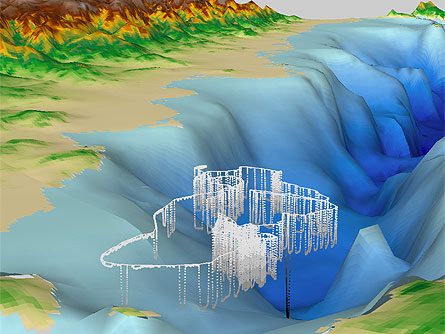Whales may round up squid for dinner
Tracking sperm whale movements suggests groups herd to hunt.
If you were swimming in the ocean, it would be hard for you to miss sperm whales swimming by. They’re longer than the average school bus — males can grow to be as long as 62 feet — and once every hour or so they come to the surface and breathe. In a recent study, scientists found evidence that sperm whales may work together to hunt and feed.
This is very bad news indeed for certain types of squid.
Scientists already knew that sperm whales, like a lot of mammals, can come together to form communities. Some researchers think that these groups, usually females and young whales, raise their young together. The new study suggests that in addition to raising whales, these groups also cooperate when they’re going after a meal.
Sperm whales usually feast on squid, but to catch these animals the whales sometimes have to dive thousands of feet below the ocean surface. In 2007 and 2008, scientists set out to study groups of sperm whales swimming in the Gulf of California. They attached a tiny device, about the size of a hockey puck, to some of the whales. These devices recorded information about where and to what depths the whales were swimming.
The devices stayed attached for up to a month, then broke free and floated to the surface so that the scientists could retrieve them. In looking at the data from these devices, the researchers were surprised to find that, when diving to the deep, the whales followed unexpected patterns. Some whales zigzagged back and forth, and it appeared that the whales did not all follow the same paths.
 |
|
One sperm whale’s movements over seven days (traced in image) show the animal making many deep dives in a small area.
|
| Mate et al., Oregon State University Marine Mammal Institute |
“We expected their dives to be similar, but often one of the three whales went deeper than the other two,” Bruce Mate told a group of scientists and reporters at a scientific meeting in February. Mate is the director of Oregon State University’s Marine Mammal Institute, which is in Newport.
Mate and his team suspect that some whales were herding individual squid into one large group — so that other whales could swim right into the middle of the squid-huddle and feast. Other animals, such as sea lions and dolphins, herd fish in a similar way: Some members of the group gather together the food, the others eat.
Mate’s team suggests that the deepest diving whale was preventing squid from swimming downward to escape. The sperm whales may take turns doing the deep diving because it’s difficult to dive so deep in the ocean.
Mate’s research suggests that sperm whales are herding but, doesn’t deliver proof, says Kelly Benoit-Bird. She is a biological oceanographer at Oregon State’s main campus in Corvallis. The scientists only looked at whales, not whales’ prey, she says, so it’s difficult to tell exactly what was happening with the squid. There are two sides to this story: the whales’, and the squid’s.
So now, Mate is headed back to the ocean — to study the squid. But it won’t be easy: Unlike fish, which show up on sonar because they have air bladders, squid are harder to find. Plus, Mate won’t be the only one searching for squid: The sperm whales are still out there, and they’re hungry.







